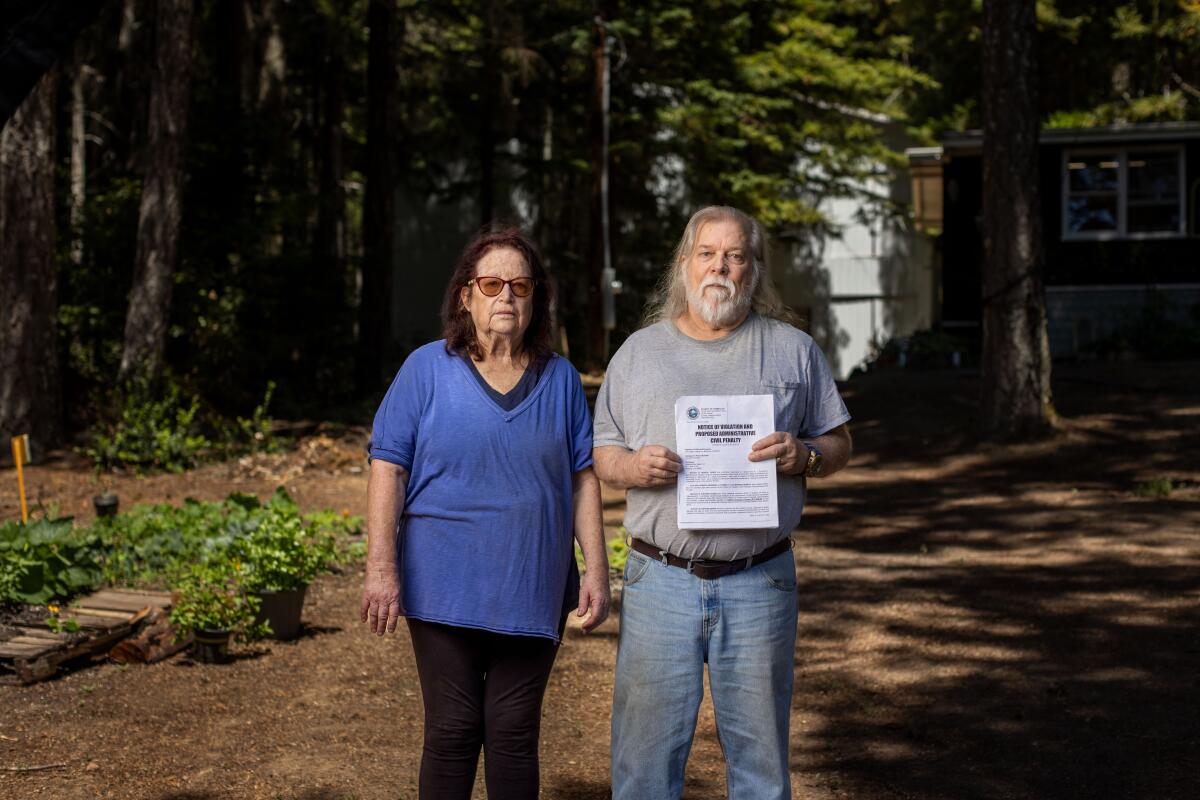Nasty surprise for new homeowners: Daily fines for previous owners’ pot operation

- Share via
After losing their previous residence in the 2018 Woolsey fire, Corrine and Doug Thomas believed they’d found a safe place to call home in Humboldt County.
They would quickly learn that the three-story building in the backyard of the property they’d bought was not only unpermitted but had been used by the previous owners to cultivate cannabis illegally. That structure would lead the county to impose $1 million in citations and fees.
They’re not alone; two other property owners have joined the Thomases in a class-action lawsuit claiming that Humboldt County is enforcing its rules unfairly, making it difficult for them to get permits for the structures and tacking on large fines for the previous illegal cultivation. Their story provides a cautionary tale for prospective home buyers across California: Don’t ignore a property’s history.

The property in Miranda, an unincorporated community in Humboldt County, had been raided by the county code enforcement department in 2019, when officials shut down an illicit cannabis operation there. They cited its then-owners for unlicensed cultivation and an unpermitted structure, resulting in an administrative penalty of $12,000 for 90 days.
Six days after the Thomases purchased the property, the county ordered them to cease cultivation — which the Thomases never engaged in, the couple says in court papers — and tear down the unpermitted building.
What do you do if you’re annoyed by neighbors smoking weed? How do you find clean wax? What are my first steps in using cannabis to combat appetite loss from chemotherapy? Why doesn’t L.A. have more weed lounges?
The Thomases say they couldn’t afford to pay the $180,000 plus the cost of permits needed to rip down the structure — they used insurance money from the home they lost in the Woolsey fire to puchase the Miranda property, according to their lawsuit. Nor did they want to tear it down.
What followed, and is still dragging on, is a back-and-forth legal fight with the county over whether the Thomases and other property owners in the lawsuit can obtain the permits their structures need without having to pay fees for the crimes of the previous owners.
According to attorney Jared McClain of the Institute for Justice, which is representing the homeowners, no outstanding permit violations showed up in the title search done when the properties were being purchased.
The Times asked real estate experts to weigh in on whether a new homeowner can be held legally responsible for past owner’s property violations, and if so, what prospective home buyers should be doing to protect their future investment. Here are their insights.
As a new owner, am I responsible for a previous owner’s property violations?
When it involves code enforcement violations, the local government is always going to look to the current owner of the property as the person that’s liable or responsible, said Kirk Pearson, an attorney in Aliso Viejo who focuses on real estate disputes.
The government agency’s focus is on the noncompliant property, said Gov Hutchinson, assistant general counsel for the California Assn. of Realtors. So whoever the owner is now, they’re the ones responsible, he said.
If the seller fails to tell the buyer that a structure or any type of work on a property wasn’t permitted, the buyer could conceivably sue the seller for not disclosing this information.
A seller’s obligation to the buyer
Sellers in California are legally obligated to disclose any facts about or defects in their property that could affect its value, including unpermitted work on the property, Hutchinson said.
Nevertheless, there are scenarios where the information might not be disclosed. Hutchinson said this can happen if the seller was unaware of such issues with the property (the unpermitted work was done by an owner before them), the seller is unaware they’re supposed to disclose that information, or the seller is trying to conceal the issues.
Regardless of the seller’s awareness and motives, sellers legally must disclose this information to buyers after a bid is accepted but before the sale is finalized.
In the Bay Area, Hutchinson said, it’s standard practice to make disclosures about a property online before a prospective home buyer even makes an offer.
You can’t trust that a seller has your best interest in mind when purchasing their property, experts warn, so it makes sense to investigate the property’s history before completing the purchase. This can be done by having the property inspected and requesting permit records.
You’ll have to pay for the inspection and possibly administrative fees from your local government when requesting records, “but it’ll save you a headache in the long run,” Pearson said.
Amid California’s housing crisis, some small communities persist with property values well below the statewide norm.
A buyer’s homework
During the home-buying process, a prospective buyer can have the entire property inspected, which by law is supposed to identify “material defects” in the structure, its plumbing, its wiring and other key components.
If something looks off or potentially problematic, then the buyer needs to do further investigation and ask for additional information, said Pearson.
Inspectors are not required to check whether structures or improvements were made without permits. But an inspector can point out structures and improvements that don’t comply with building codes, which would raise a red flag about potentially unpermitted construction. Just bear in mind that building codes have grown more demanding over time, so the fact that something doesn’t comply with the codes today doesn’t mean that it wasn’t compliant and permitted when built.
It’s up to buyers to go to their local government’s offices and request property and land use records to verify if construction or other work on the property was permitted, Hutchinson said.
Should I keep the inspection contingency?
You aren’t required to conduct an inspection or insist that the property pass inspection before the sale becomes final, a demand known as the inspection contingency in your purchase contract. Waiving the contingency can make an offer more competitive; however, it also carries risks, said Ruthie Jones, president of the Humboldt Assn. of Realtors.
Jones said the benefits of keeping the contingency include the following:
- It provides protection for the buyer by allowing them to uncover any hidden issues with the property.
- It gives the buyer leverage to negotiate repairs or credits based on the inspection findings.
- It gives the buyer peace of mind knowing the condition of the property before finalizing the purchase.
The benefits of waiving the contingency, she said, include the following:
- In a competitive market, waiving the contingency can make the offer more attractive to the seller, potentially giving the buyer an edge over other bidders.
- Removing the contingency can expedite the home-buying process because inspections won’t delay the transaction.
- Waiving it may signal to the seller that the buyer is serious and committed to the purchase.
“Buyers should carefully consider their options and consult with their real estate agent or attorney before making a decision,” she said.
Major insurers have pulled back from California’s homeowners market, citing wildfires, inflation and other challenges. But there are steps at-risk homeowners can take now to secure coverage and at lower prices.
In California’s tight housing market, people feel pressure to move quickly through escrow, so they waive inspection just because “they want to get it done and they’re worried somebody else is going to buy it,” said Pearson.
The issue with this approach is the buyer might not be looking at a property thoroughly.
Without a complete investigation, Pearson said, you could be buying a property that has unpermitted work, mold, electrical system issues or furnace and air conditioning issues — all problems you’ll have to correct over time.
Said Pearson, “It is still worth missing out on a property and continuing your search [so you can] be certain that you’re buying something that’s really going to fit your needs — and isn’t going to cause you a lot of future problems.”
More to Read
Sign up for Essential California
The most important California stories and recommendations in your inbox every morning.
You may occasionally receive promotional content from the Los Angeles Times.














